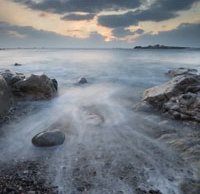Hasselblad H6D-100c versus Nikon D850: What are the real-world advantages of a medium-format camera?
posted Friday, July 13, 2018 at 1:30 PM EDT

Photographer Karl Taylor has extensive experience in the photographic industry, having worked with numerous types of camera technologies for over 20 years. Hasselblad is incredibly confident in their latest digital medium-format cameras and has asked Taylor to show the differences between 35mm and medium format in an "unbiased manner." Of course, the videos are for Hasselblad, so take "unbiased" as you will. Nonetheless, the series of four videos, seen below, are interesting and there are certainly interesting differences between the two camera systems in terms of image quality.
The first video shows Mr. Taylor working with a leading 35mm camera and a Hasselblad H6D-100c at sunset. The full-frame camera in use is the 45-megapixel Nikon D850. In both cases, each camera is affixed with the same neutral density and graduated neutral density filters. After shooting, Taylor shows us the differences in the files. It's no surprise that the 100-megapixel medium-format camera captures images with greater detail than the D850.
After sunset shooting has been compared and contrasted, let's take a look at sunrise. In this comparison, Taylor focuses in on shadow detail, noting that the larger sensor does a better job in this respect. You can see the shooting and image review below.
A studio shoot is a popular place for medium-format cameras. This is the next test.
In the fourth video, things take a slightly different turn. We know that a higher-resolution sensor that is larger and offers more megapixels will deliver images with more detail. However, what about the potential depth of field advantages of a larger sensor? It's often claimed that medium-format cameras produce images with a more three-dimensional appearance. This is hard to quantify, but nonetheless, we can see some differences in the video below.
Of the differences between medium format and 35mm, Karl Taylor says, "The medium format image has a lot more bite and a lot more contrast, a lot more richness, but again it comes down to that smoothness of transition of tonal range that is afforded by the larger sensor.” Hasselblad states that Taylor consistently found that the medium format camera was the better choice.
Of course, there is more to comparing cameras than just pure image quality. The medium-format camera system is larger, heavier and substantially more expensive. The H6D-100C camera itself is over $30,000 USD, for example, whereas a D850 is just over $3,000. Further, the D850 is a much faster camera in terms of shooting and autofocus and has a vastly larger and more diverse selection of lenses. I would have liked to see the cameras compared in sports, wildlife or street photography situations in addition to the landscape and studio scenarios.
Ultimately, there's no doubt that something like the Hasselblad H6D-100c captures images with stunning detail and fantastic dynamic range. In a like for like test, it's obviously going to produce a better large print than a 35mm camera with half the megapixels. However, if you're comparing cameras in terms of overall usability, affordability and versatility, the advantages of a medium-format system are not so clear-cut and frankly, a smaller-sensored camera can win out in many situations.
(Via Hasselblad)